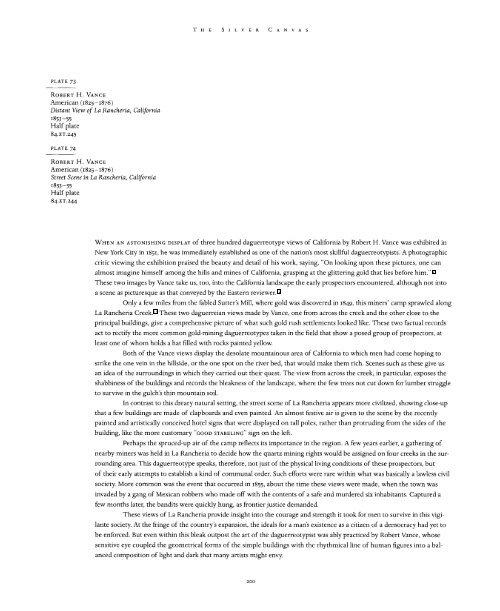The Silver Canvas - Daguerrotype Masterpieces (Art Photography Ebook)
Create successful ePaper yourself
Turn your PDF publications into a flip-book with our unique Google optimized e-Paper software.
T H E S I L V E R C A N V A S<br />
PLATE 73<br />
ROBERT H. VANCE<br />
American (1825-1876)<br />
Distant View of La Rancheria, California<br />
1853-55<br />
Half plate<br />
84.XT.245<br />
PLATE 74<br />
ROBERT H. VANCE<br />
American (1825-1876)<br />
Street Scene in La Rancheria, California<br />
1853-55<br />
Half plate<br />
84.XT.244<br />
WHEN AN ASTONISHING DISPLAY of three hundred daguerreotype views of California by Robert H. Vance was exhibited in<br />
New York City in 1851, he was immediately established as one of the nations most skillful daguerreotypists. A photographic<br />
critic viewing the exhibition praised the beauty and detail of his work, saying, "On looking upon these pictures, one can<br />
almost imagine himself among the hills and mines of California, grasping at the glittering gold that lies before him." u<br />
<strong>The</strong>se two images by Vance take us, too, into the California landscape the early prospectors encountered, although not into<br />
a scene as picturesque as that conveyed by the Eastern reviewer. 12<br />
Only a few miles from the fabled Sutter's Mill, where gold was discovered in 1849, this miners' camp sprawled along<br />
La Rancheria Creek. 13 <strong>The</strong>se two daguerreian views made by Vance, one from across the creek and the other close to the<br />
principal buildings, give a comprehensive picture of what such gold rush settlements looked like. <strong>The</strong>se two factual records<br />
act to rectify the more common gold-mining daguerreotypes taken in the field that show a posed group of prospectors, at<br />
least one of whom holds a hat filled with rocks painted yellow.<br />
Both of the Vance views display the desolate mountainous area of California to which men had come hoping to<br />
strike the one vein in the hillside, or the one spot on the river bed, that would make them rich. Scenes such as these give us<br />
an idea of the surroundings in which they carried out their quest. <strong>The</strong> view from across the creek, in particular, exposes the<br />
shabbiness of the buildings and records the bleakness of the landscape, where the few trees not cut down for lumber struggle<br />
to survive in the gulch's thin mountain soil.<br />
In contrast to this dreary natural setting, the street scene of La Rancheria appears more civilized, showing close-up<br />
that a few buildings are made of clapboards and even painted. An almost festive air is given to the scene by the recently<br />
painted and artistically conceived hotel signs that were displayed on tall poles, rather than protruding from the sides of the<br />
building, like the more customary "GOOD STABELING" sign on the left.<br />
Perhaps the spruced-up air of the camp reflects its importance in the region. A few years earlier, a gathering of<br />
nearby miners was held in La Rancheria to decide how the quartz mining rights would be assigned on four creeks in the surrounding<br />
area. This daguerreotype speaks, therefore, not just of the physical living conditions of these prospectors, but<br />
of their early attempts to establish a kind of communal order. Such efforts were rare within what was basically a lawless civil<br />
society. More common was the event that occurred in 1855, about the time these views were made, when the town was<br />
invaded by a gang of Mexican robbers who made off with the contents of a safe and murdered six inhabitants. Captured a<br />
few months later, the bandits were quickly hung, as frontier justice demanded.<br />
<strong>The</strong>se views of La Rancheria provide insight into the courage and strength it took for men to survive in this vigilante<br />
society. At the fringe of the country's expansion, the ideals for a man's existence as a citizen of a democracy had yet to<br />
be enforced. But even within this bleak outpost the art of the daguerreotypist was ably practiced by Robert Vance, whose<br />
sensitive eye coupled the geometrical forms of the simple buildings with the rhythmical line of human figures into a balanced<br />
composition of light and dark that many artists might envy.<br />
200


